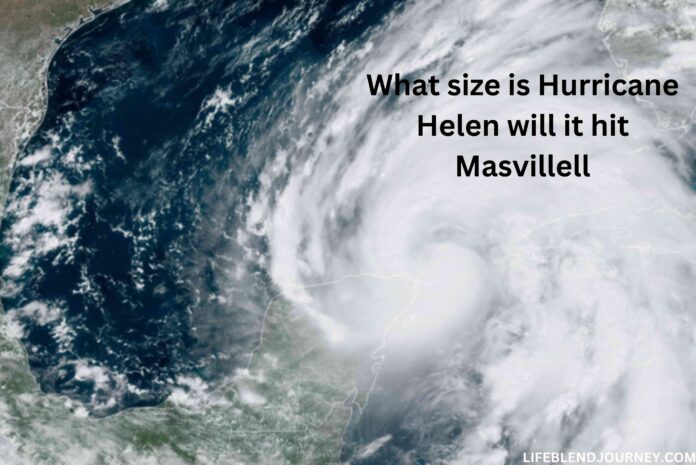Introduction
Naturally, people have questions when hurricanes are approaching. What is Hurricane Helen’s size? Many locals are wondering, what size is hurricane Helen will it hit masvillell as they brace for the worst but hold out hope for the best. The magnitude, power, and possible effects of Hurricane Helen on Maysville will be discussed in this article. You’ll know exactly what to anticipate and how to be safe by the end.
What Is Hurricane Helen?
Hurricane Helen is the latest tropical storm to form during this hurricane season. It has been gaining strength over the past few days and is now classified as a hurricane. But what exactly is a hurricane? Simply put, it’s a massive storm system characterized by strong winds, heavy rainfall, and an eye of relative calm at its center. Hurricanes form over warm ocean waters and can cause significant damage when they make landfall.
How Are Hurricanes Measured?
The Saffir-Simpson Hurricane Wind Scale measures hurricanes. This scale categorizes hurricanes into five levels based on their wind speeds:
- Category 1: Winds of 74-95 mph
- Category 2: Winds of 96-110 mph
- Category 3: Winds of 111-129 mph
- Category 4: Winds of 130-156 mph
- Category 5: Winds exceeding 157 mph
The scale gives a general idea of a hurricane’s potential for destruction, with higher categories posing greater risks.
Current Size of Hurricane Helen
As of now, Hurricane Helen is classified as a Category 3 storm with sustained winds of 120 mph. Its diameter spans approximately 400 miles, making it a large storm capable of widespread impacts. Helen’s size and intensity make it a force to be reckoned with, particularly for areas in its projected path.
Predicted Path of Hurricane Helen
Meteorologists use advanced models to predict a hurricane’s path. These models consider factors like wind patterns, ocean temperatures, and atmospheric pressure. Currently, Hurricane Helen is moving northwest at 15 mph. While its exact path remains uncertain, projections suggest it may approach the southeastern coast within the next 72 hours.
Factors That Influence Hurricane Paths
Several factors determine a hurricane’s path:
- High and Low-Pressure Systems: These act as steering currents, guiding the hurricane’s direction.
- Ocean Temperatures: Warm waters fuel the storm, while cooler waters can weaken it.
- Wind Shear: High wind shear can disrupt a hurricane’s structure, altering its trajectory.
Understanding these elements helps forecasters make more accurate predictions.
Will Hurricane Helen Hit Maysville?
While it’s too early to say for certain, Maysville lies within the potential impact zone. Residents should prepare for the possibility of strong winds, heavy rainfall, and localized flooding. Keeping a close eye on updates from the National Hurricane Center is crucial.
Potential Impacts on Maysville
If Hurricane Helen makes landfall near Maysville, the town could face:
- High Winds: Strong gusts capable of uprooting trees and damaging structures.
- Heavy Rainfall: Flooding in low-lying areas and along rivers.
- Power Outages: Downed power lines disrupting electricity.
- Storm Surge: Coastal areas could experience significant water level rises.
How to Prepare for a Hurricane
Preparation can make a world of difference. Here are some tips:
- Stock Up: Gather non-perishable food, water, and medical supplies.
- Secure Your Home: Board up windows and reinforce doors.
- Have a Plan: Know evacuation routes and shelters.
- Stay Informed: Monitor reliable sources for updates.
Emergency Resources for Maysville Residents
Maysville residents can rely on several resources during a hurricane:
- Local Emergency Management Offices
- Red Cross Shelters
- FEMA Assistance
- Community Hotlines
Having these resources at your fingertips ensures a quicker response during an emergency.
Lessons from Past Hurricanes
Hurricane history has taught us valuable lessons:
- Hurricane Sandy (2012): Emphasized the importance of preparedness.
- Hurricane Katrina (2005): Highlighted the need for effective evacuation plans.
- Hurricane Harvey (2017): Showed the devastating effects of prolonged rainfall.
Climate Change and Hurricanes
Hurricanes are becoming more common and severe due to climate change. Warmer oceans provide more energy for storms, resulting in higher wind speeds and greater rainfall. Understanding this link helps us prepare for the future.
Staying Updated on Hurricane Helen
Stay informed by following:
- National Hurricane Center
- Local News Outlets
- Weather Apps
Timely updates ensure you’re always prepared.
What Comes After the Storm?
Once the storm passes, focus on recovery:
- Assess Damage: Inspect your property for safety.
- Help Neighbors: Offer assistance to those in need.
- Follow Guidelines: Adhere to local authorities’ instructions.
Conclusion
One powerful storm that could affect Maysville is Hurricane Helen. You and your loved ones can be protected if you remain knowledgeable and organised. Never forget that being overprepared is always preferable to being underprepared.
FAQs
- What category is Hurricane Helen currently? Hurricane Helen is currently a Category 3 storm with sustained winds of 120 mph.
- Will Hurricane Helen directly hit Maysville? It’s too early to confirm, but Maysville lies within the potential impact zone.
- How can I stay updated on Hurricane Helen’s path? Follow updates from the National Hurricane Center, local news, and weather apps.
- What should I include in a hurricane emergency kit? Include water, non-perishable food, medical supplies, flashlights, batteries, and important documents.
- How does climate change affect hurricanes? Climate change leads to warmer oceans, which can intensify hurricanes, making them stronger and more destructive.
